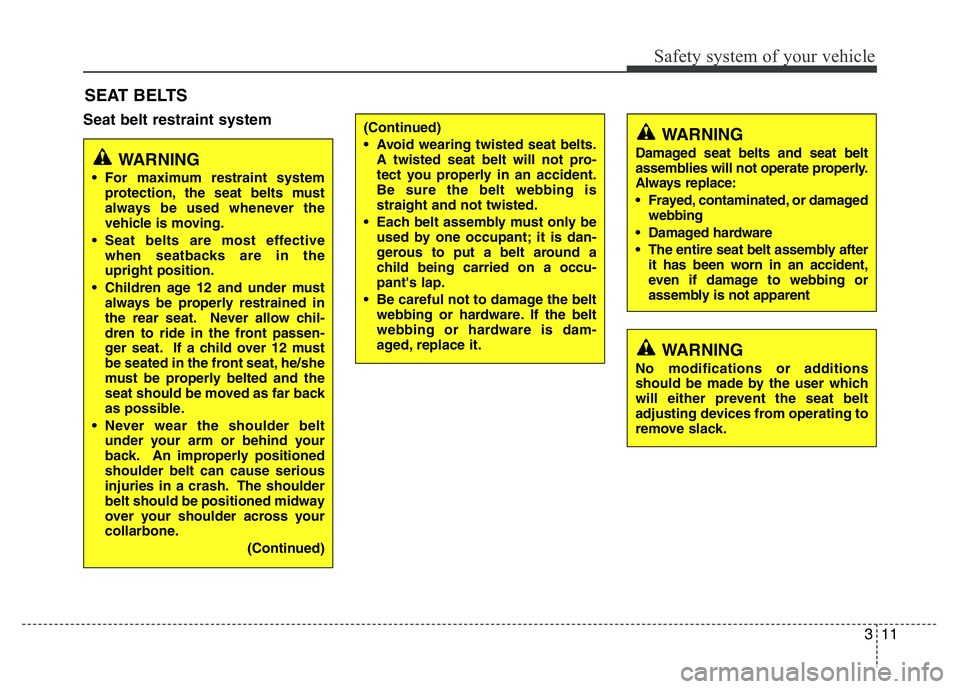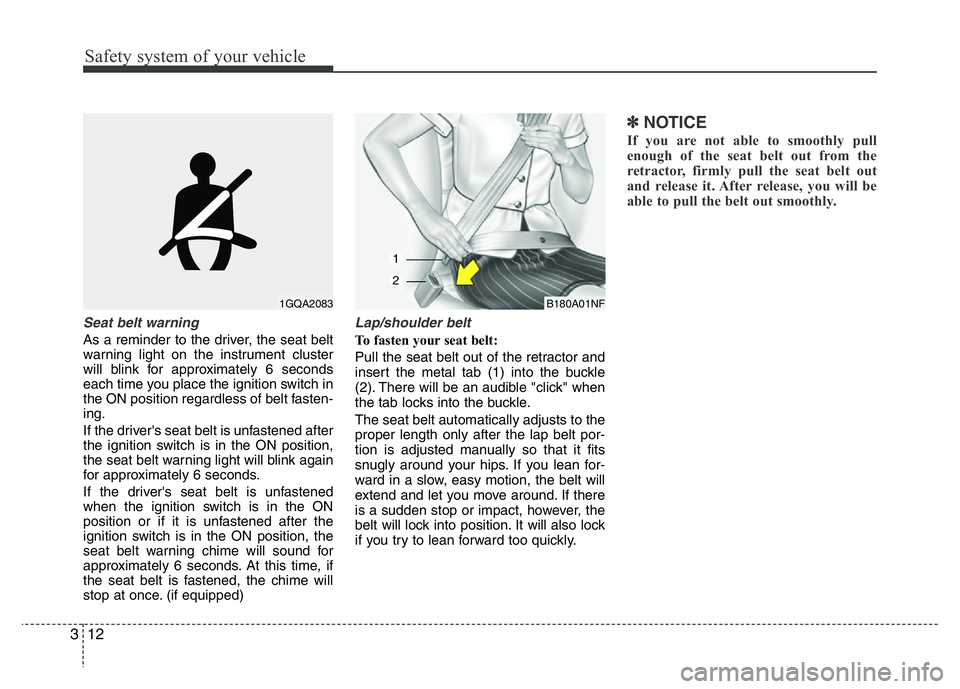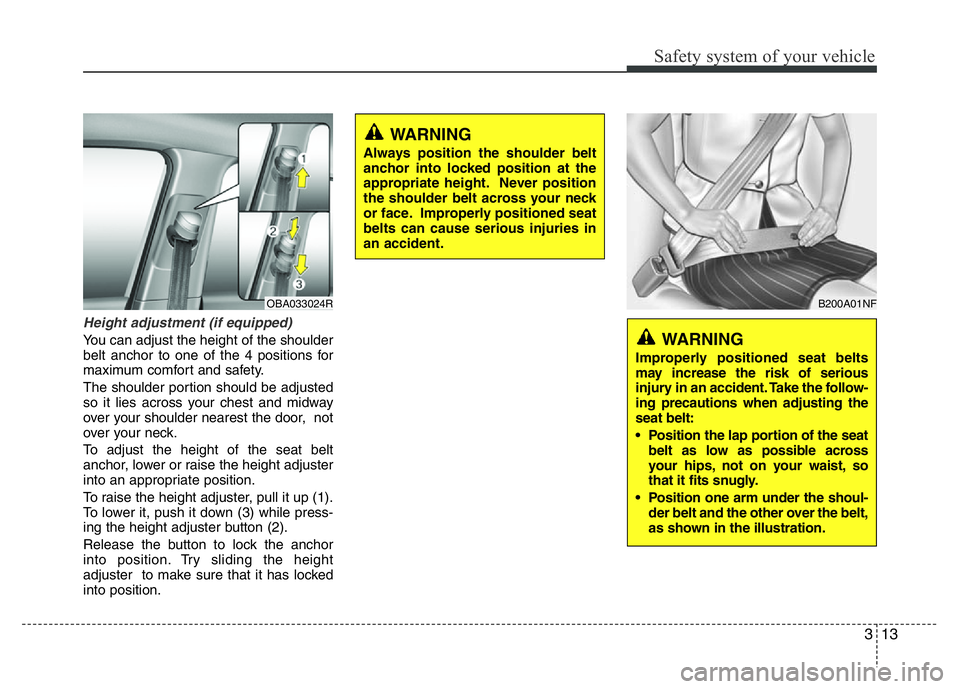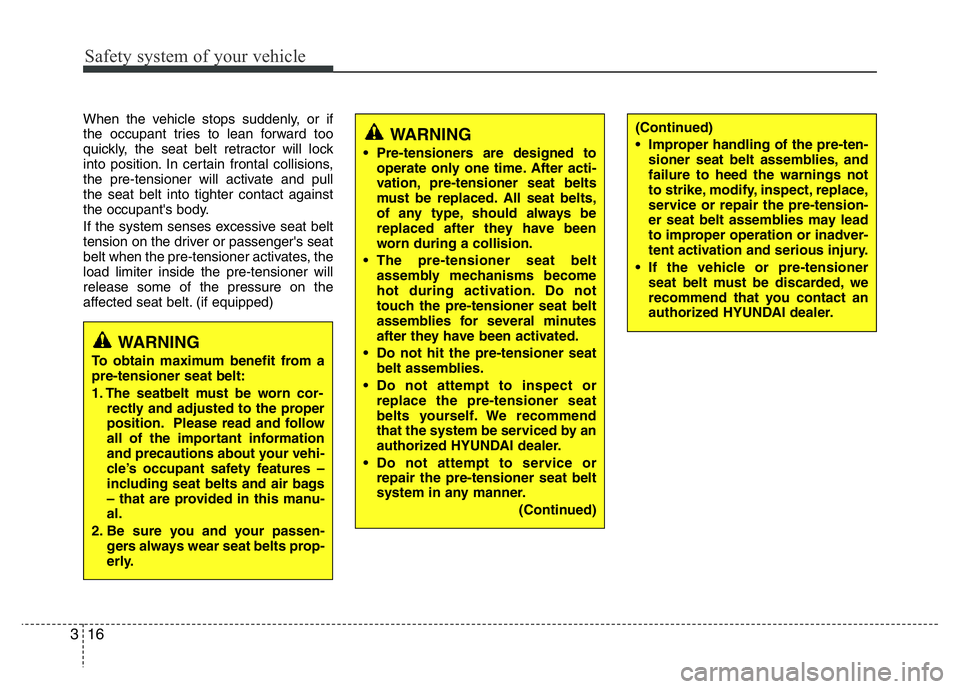2018 HYUNDAI I10 warning
[x] Cancel search: warningPage 23 of 343

37
Safety features of your vehicle
Removal/Reinstall (if equipped)
To remove the headrest, raise it as far as
it can go then press the release button (1)
while pulling the headrest up (2).
To reinstall the headrest, put the head-
rest poles (3) into the holes while press-
ing the release button (1). Then adjust it
to the appropriate height.Seatback pocket (if equipped)
The seatback pocket is provided on the
back of the driver’s and/or front passen-
ger’s seatback.
Passenger seat under tray
(if equipped)
To open the tray, pull up the tray and then
pull it out forward.
OBA033006
WARNING
Always make sure the headrest
locks into position after reinstalling
and adjusting it properly.
WARNING- Seatback
pocket
Do not put heavy or sharp objects
in the seatback pocket. In an acci-
dent they could come loose from
the pocket and injure vehicle occu-
pants.
WARNING- Flammable
materials
Do not store cigarette lighters,
propane cylinders, or other flamma-
ble/explosive materials in the tray.
These items may catch fire and/or
explode if the vehicle is exposed to
hot temperatures for extended peri-
ods.
OBA033031LOPA037007
Page 24 of 343

Safety features of your vehicle
8 3
Rear seat adjustment
Headrest
The rear seat(s) is equipped with head-
rests in the outboard seating positions
(and/or center seating position) for the
occupant's safety and comfort.
The headrest not only provides comfort
for passengers, but also helps protect
the head and neck in the event of a colli-
sion.Adjusting the height up and down
(if equipped)
To raise the headrest, pull it up to the
desired position (1). To lower the head-
rest, push and hold the release button (2)
on the headrest support and lower the
headrest to the desired position (3).
WARNING
To reduce the risk of serious injury
or death in an accident, take the fol-
lowing precautions when adjusting
your headrests:
• Always properly adjust the head-
rests for all passengers BEFORE
starting the vehicle.
• NEVER let anyone ride in a seat
with the headrest removed.
• Adjust the headrests so the mid-
dle of the headrests is at the
same height as the height of the
top of the eyes (see diagram).
• Adjust the headrest as close to
the passenger's head as possi-
ble. Do not use a seat cushion
that holds the body away from
the seatback.
OBA033025OPA039053
Page 25 of 343

39
Safety features of your vehicle
Removal/Reinstall (if equipped)
To remove the headrest, slightly fold the
rear seatback, raise the headrest as far
as it can go then press the release button
(1) while pulling upward (2).
To reinstall the headrest, put the head-
rest poles (3) into the holes while press-
ing the release button (1). Then adjust it
to the appropriate height.
Folding the rear seat
The rear seatbacks (or cushions) may be
folded to facilitate carrying long items or
to increase the luggage capacity of the
vehicle.
1. Set the front seatback to the upright
position and if necessary, slide the
front seat forward.
2. Lower the rear headrests to the lowest
position (if equipped with adjustable
headrests).3. Insert the rear lap/shoulder belt plate
into the holder on the side trim. It will
prevent the lap/shoulder belt from
interfering with the seatback when fold-
ing.
WARNING
• Never allow passengers to sit on
top of the folded down seatback
while the vehicle is moving as
this is not a proper seating posi-
tion and no seat belts are avail-
able for use. This could result in
serious injury or death in case of
an accident or sudden stop.
• Objects carried on the folded
down seatback should not extend
higher than the top of the front
seats. This could allow cargo to
slide forward and cause injury or
damage during sudden stops.
OBA033026OBA033027
WARNING
Always make sure the headrest
locks into position after reinstalling
and adjusting it properly.
Page 26 of 343

Safety system of your vehicle
10 3
4. Pull up both sides of the seatback lever
and fold the seatback toward the front
of the vehicle.To use the rear seat, lift and push up the
seatback backward. Push the seatback
firmly until it clicks into place. Make sure
the seatback is locked in place.
When returning the rear seatbacks to the
upright position, remember to return the
rear shoulder belts to their proper position.
WARNING
When returning the rear seatback
from a folded to an upright posi-
tion, hold the seatback and return it
slowly. Ensure that the seatback is
completely locked into its upright
position by pushing on the top of
the seatback. In an accident or sud-
den stop, the unlocked seatback
could allow cargo to move forward
with great force and enter the pas-
senger compartment, which could
result in serious injury or death.
WARNING- Cargo
Cargo should always be secured to
prevent it from being thrown about
the vehicle in a collision and caus-
ing injury to the vehicle occupants.
Do not place objects in the rear
seats, since they cannot be proper-
ly secured and may hit the front
seat occupants in a collision.
WARNING - Cargo loading
Make sure the engine is off, the
shift lever is in P (Park, for auto-
matic transaxle vehicle ) or neutral
(for manual transaxle vehicle), and
the parking brake is securely
applied whenever loading or
unloading cargo. Failure to take
these steps may allow the vehicle
to move if the shift lever is inadver-
tently moved to another position.
OBA033028
OBA033029
Page 27 of 343

311
Safety system of your vehicle
Seat belt restraint system
SEAT BELTS
(Continued)
• Avoid wearing twisted seat belts.
A twisted seat belt will not pro-
tect you properly in an accident.
Be sure the belt webbing is
straight and not twisted.
• Each belt assembly must only be
used by one occupant; it is dan-
gerous to put a belt around a
child being carried on a occu-
pant's lap.
• Be careful not to damage the belt
webbing or hardware. If the belt
webbing or hardware is dam-
aged, replace it.WARNING
Damaged seat belts and seat belt
assemblies will not operate properly.
Always replace:
• Frayed, contaminated, or damaged
webbing
• Damaged hardware
• The entire seat belt assembly after
it has been worn in an accident,
even if damage to webbing or
assembly is not apparent
WARNING
No modifications or additions
should be made by the user which
will either prevent the seat belt
adjusting devices from operating to
remove slack.
WARNING
• For maximum restraint system
protection, the seat belts must
always be used whenever the
vehicle is moving.
• Seat belts are most effective
when seatbacks are in the
upright position.
• Children age 12 and under must
always be properly restrained in
the rear seat. Never allow chil-
dren to ride in the front passen-
ger seat. If a child over 12 must
be seated in the front seat, he/she
must be properly belted and the
seat should be moved as far back
as possible.
• Never wear the shoulder belt
under your arm or behind your
back. An improperly positioned
shoulder belt can cause serious
injuries in a crash. The shoulder
belt should be positioned midway
over your shoulder across your
collarbone.
(Continued)
Page 28 of 343

Safety system of your vehicle
12 3
Seat belt warning
As a reminder to the driver, the seat belt
warning light on the instrument cluster
will blink for approximately 6 seconds
each time you place the ignition switch in
the ON position regardless of belt fasten-
ing.
If the driver's seat belt is unfastened after
the ignition switch is in the ON position,
the seat belt warning light will blink again
for approximately 6 seconds.
If the driver's seat belt is unfastened
when the ignition switch is in the ON
position or if it is unfastened after the
ignition switch is in the ON position, the
seat belt warning chime will sound for
approximately 6 seconds. At this time, if
the seat belt is fastened, the chime will
stop at once. (if equipped)
Lap/shoulder belt
To fasten your seat belt:
Pull the seat belt out of the retractor and
insert the metal tab (1) into the buckle
(2). There will be an audible "click" when
the tab locks into the buckle.
The seat belt automatically adjusts to the
proper length only after the lap belt por-
tion is adjusted manually so that it fits
snugly around your hips. If you lean for-
ward in a slow, easy motion, the belt will
extend and let you move around. If there
is a sudden stop or impact, however, the
belt will lock into position. It will also lock
if you try to lean forward too quickly.
✽NOTICE
If you are not able to smoothly pull
enough of the seat belt out from the
retractor, firmly pull the seat belt out
and release it. After release, you will be
able to pull the belt out smoothly.
1GQA2083B180A01NF
1
2
Page 29 of 343

313
Safety system of your vehicle
Height adjustment (if equipped)
You can adjust the height of the shoulder
belt anchor to one of the 4 positions for
maximum comfort and safety.
The shoulder portion should be adjusted
so it lies across your chest and midway
over your shoulder nearest the door, not
over your neck.
To adjust the height of the seat belt
anchor, lower or raise the height adjuster
into an appropriate position.
To raise the height adjuster, pull it up (1).
To lower it, push it down (3) while press-
ing the height adjuster button (2).
Release the button to lock the anchor
into position. Try sliding the height
adjuster to make sure that it has locked
into position.
WARNING
Always position the shoulder belt
anchor into locked position at the
appropriate height. Never position
the shoulder belt across your neck
or face. Improperly positioned seat
belts can cause serious injuries in
an accident.
B200A01NF
WARNING
Improperly positioned seat belts
may increase the risk of serious
injury in an accident. Take the follow-
ing precautions when adjusting the
seat belt:
• Position the lap portion of the seat
belt as low as possible across
your hips, not on your waist, so
that it fits snugly.
• Position one arm under the shoul-
der belt and the other over the belt,
as shown in the illustration.
OBA033024R
Page 32 of 343

Safety system of your vehicle
16 3
When the vehicle stops suddenly, or if
the occupant tries to lean forward too
quickly, the seat belt retractor will lock
into position. In certain frontal collisions,
the pre-tensioner will activate and pull
the seat belt into tighter contact against
the occupant's body.
If the system senses excessive seat belt
tension on the driver or passenger's seat
belt when the pre-tensioner activates, the
load limiter inside the pre-tensioner will
release some of the pressure on the
affected seat belt. (if equipped)(Continued)
• Improper handling of the pre-ten-
sioner seat belt assemblies, and
failure to heed the warnings not
to strike, modify, inspect, replace,
service or repair the pre-tension-
er seat belt assemblies may lead
to improper operation or inadver-
tent activation and serious injury.
• If the vehicle or pre-tensioner
seat belt must be discarded, we
recommend that you contact an
authorized HYUNDAI dealer.WARNING
• Pre-tensioners are designed to
operate only one time. After acti-
vation, pre-tensioner seat belts
must be replaced. All seat belts,
of any type, should always be
replaced after they have been
worn during a collision.
• The pre-tensioner seat belt
assembly mechanisms become
hot during activation. Do not
touch the pre-tensioner seat belt
assemblies for several minutes
after they have been activated.
• Do not hit the pre-tensioner seat
belt assemblies.
• Do not attempt to inspect or
replace the pre-tensioner seat
belts yourself. We recommend
that the system be serviced by an
authorized HYUNDAI dealer.
• Do not attempt to service or
repair the pre-tensioner seat belt
system in any manner.
(Continued)
WARNING
To obtain maximum benefit from a
pre-tensioner seat belt:
1. The seatbelt must be worn cor-
rectly and adjusted to the proper
position. Please read and follow
all of the important information
and precautions about your vehi-
cle’s occupant safety features –
including seat belts and air bags
– that are provided in this manu-
al.
2. Be sure you and your passen-
gers always wear seat belts prop-
erly.